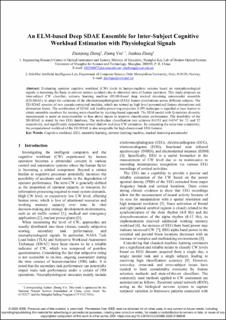| dc.contributor.author | Zheng, Zhanpeng | |
| dc.contributor.author | Yin, Zhong | |
| dc.contributor.author | Zhang, Jianhua | |
| dc.date.accessioned | 2021-09-01T08:18:13Z | |
| dc.date.available | 2021-09-01T08:18:13Z | |
| dc.date.created | 2021-01-29T18:32:44Z | |
| dc.date.issued | 2020-09-09 | |
| dc.identifier.citation | Chinese Control Conference (CCC). 2020, 6237-6242. | en_US |
| dc.identifier.isbn | 978-9-8815-6390-3 | |
| dc.identifier.isbn | 978-1-7281-6523-3 | |
| dc.identifier.issn | 1934-1768 | |
| dc.identifier.uri | https://hdl.handle.net/11250/2772135 | |
| dc.description.abstract | Evaluating operator cognitive workload (CW) levels in human-machine systems based on neurophysiological signals is becoming the basis to prevent serious accidents due to abnormal state of human operators. This study proposes an inter-subject CW classifier, extreme learning machine (ELM)-based deep stacked denoising autoencoder ensemble (ED-SDAE), to adapt the variations of the electroencephalogram (EEG) feature distributions across different subjects. The ED-SDAE consists of two cascade-connected modules, which are termed as high level personalized feature abstractions and abstraction fusion. The combination of SDAE and locality preserving projection (LPP) technique is regarded as base learner to obtain ensemble members for training meta-classifier by stacking-based approach. The ELM model with Q-statistics diversity measurement is acted as meta-classifier to fuse above inputs to improve classification performance. The feasibility of the SD-SDAE is tested by two EEG databases. The multi-class classification rate achieves 0.6353 and 0.6747 for T1 and T2 respectively, and significantly outperforms several shallow and deep CW estimators. By computing the main time complexity, the computational workload of the ED-SDAE is also acceptable for high-dimensional EEG features. | en_US |
| dc.description.sponsorship | This work is sponsored by the National Natural Science Foundation of China under Grant No. 61703277 and the Shanghai Sailing Program (17YF1427000). | en_US |
| dc.language.iso | eng | en_US |
| dc.publisher | Institute of Electrical and Electronics Engineers | en_US |
| dc.relation.ispartof | 2020 39th Chinese Control Conference (CCC) | |
| dc.relation.ispartofseries | Chinese Control Conference (CCC);2020 39th Chinese Control Conference (CCC) | |
| dc.relation.uri | https://ieeexplore.ieee.org/document/9188806 | |
| dc.subject | Cognitive workloads | en_US |
| dc.subject | Electroencephalograms | en_US |
| dc.subject | Ensemble learning | en_US |
| dc.subject | Extreme learning machines | en_US |
| dc.subject | Stacked denoising autoencoders | en_US |
| dc.title | An ELM-based Deep SDAE Ensemble for Inter-Subject Cognitive Workload Estimation with Physiological Signals | en_US |
| dc.type | Conference object | en_US |
| dc.description.version | acceptedVersion | en_US |
| dc.rights.holder | © 2020 IEEE | en_US |
| cristin.ispublished | true | |
| cristin.fulltext | original | |
| cristin.fulltext | postprint | |
| cristin.qualitycode | 1 | |
| dc.identifier.doi | https://doi.org/10.23919/CCC50068.2020.9188806 | |
| dc.identifier.cristin | 1882942 | |
| dc.source.journal | Chinese Control Conference (CCC) | en_US |
| dc.source.volume | 39 | en_US |
| dc.source.issue | 2020 39th Chinese Control Conference (CCC) | en_US |
| dc.source.pagenumber | 6237-6242 | en_US |
| dc.relation.project | National Natural Science Foundation of China: 61703277 | en_US |
| dc.relation.project | Shanghai Sailing Program: 17YF1427000 | en_US |
